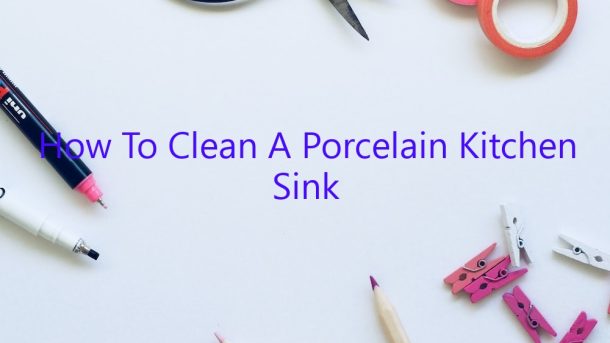There are a few simple steps you can take to clean your porcelain kitchen sink.
Start by filling the sink with hot water and adding a few drops of dish detergent. Let the suds form and then use a sponge or brush to scrub the surface of the sink. Rinse the sink with hot water and then repeat the process until the sink is clean.
If there is a build-up of grease or food on the surface of the sink, you can use a paste of baking soda and water to scrub it away.
Finally, rinse the sink with hot water and dry it with a towel.
Contents
- 1 How can I make my porcelain sink look new again?
- 2 How do I get my porcelain sink white again?
- 3 How do you get tough stains out of a porcelain sink?
- 4 What should you not clean a porcelain sink with?
- 5 Will vinegar harm porcelain sink?
- 6 Does bleach damage porcelain sinks?
- 7 How do I know if my sink is ceramic or porcelain?
How can I make my porcelain sink look new again?
A porcelain sink is a beautiful addition to any kitchen. Over time, however, it can become stained and dirty. Here are a few ways to make your porcelain sink look new again.
One way to make your porcelain sink look new again is to use a pumice stone to remove any built-up dirt and grime. Simply wet the stone, and then use it to scrub the sink. Be careful not to use too much pressure, as you could damage the porcelain.
Another way to make your sink look new again is to use a paste made of baking soda and water. Simply apply the paste to a wet cloth, and then use it to scrub the sink. Rinse the sink well afterwards.
You can also use a vinegar and water solution to clean your sink. Simply pour the solution into a spray bottle, and then spray it onto the sink. Let the solution sit for a few minutes, and then scrub the sink with a brush. Rinse the sink well afterwards.
If your porcelain sink is stained, you can use a vinegar and salt solution to remove the stains. Simply pour the solution into a spray bottle, and then spray it onto the sink. Let the solution sit for a few minutes, and then scrub the sink with a brush. Rinse the sink well afterwards.
Finally, you can use a commercial cleaner to clean your sink. Be sure to read the instructions carefully, and always test the cleaner on a small area of the sink first. Rinse the sink well afterwards.
By following these tips, you can make your porcelain sink look new again.
How do I get my porcelain sink white again?
If your porcelain sink is stained and you want to make it white again, you can use a few methods.
The first method is to use a paste of baking soda and water. Apply the paste to the stain and let it sit for a few hours. Then, scrub the area with a toothbrush.
Another method is to use bleach. Pour bleach into a spray bottle and spray it on the stain. Let it sit for a few minutes, then scrub it with a toothbrush.
Be sure to rinse the sink well after using either of these methods to remove any baking soda or bleach residue.
How do you get tough stains out of a porcelain sink?
One of the most common problems people have with porcelain sinks is getting tough stains out of them. While there are a few methods that can work, it often depends on the severity of the stain and what caused it in the first place.
If the stain is caused by food or grease, one of the most common methods for getting it out is to use a paste of baking soda and water. Apply the paste to the stain and let it sit for a few minutes before scrubbing it with a brush. If the stain is still there, you can try using vinegar as a cleaner. Pour a small amount of vinegar onto a cloth and dab it onto the stain. Let it sit for a few minutes before scrubbing it with a brush.
If the stain is caused by something like nail polish or hair dye, you may have to use a stronger cleaner. In this case, you can try using a mixture of bleach and water. Be very careful when using this mixture, as it can be dangerous if it comes into contact with your skin. Apply it to the stain and let it sit for a few minutes before scrubbing it with a brush.
What should you not clean a porcelain sink with?
There are many things you can use to clean your porcelain sink, but there are also a few things you should avoid. Here are four things you should not use to clean your porcelain sink:
1. Steel wool. Steel wool can scratch the surface of your porcelain sink.
2. Vinegar. Vinegar can etch the surface of your porcelain sink.
3. Ammonia. Ammonia can strip the finish from your porcelain sink.
4. Glass cleaner. Glass cleaner can leave a film on your porcelain sink.
Will vinegar harm porcelain sink?
Vinegar is a popular household cleaner, but can it harm porcelain sinks? The answer is yes, vinegar can harm porcelain sinks, but it depends on the type of vinegar and the amount of vinegar used.
White vinegar is a mild acid and is safe to use on porcelain sinks. However, vinegar with color or other additives, such as apple cider vinegar, can be more corrosive and may damage porcelain sinks.
If you are using vinegar to clean your porcelain sink, be sure to test it in a small, inconspicuous area before using it on the entire sink. If the vinegar is causing the porcelain to discolor or erode, stop using it and clean the sink with a non-acidic cleaner.
Does bleach damage porcelain sinks?
Bleach is a household cleaning powerhouse that can take care of some of the nastiest messes. But is it safe to use on porcelain sinks? The answer is a little complicated.
On one hand, bleach is an effective cleaner that can remove dirt, grime, and stains from porcelain sinks. It can also kill bacteria and get rid of mold and mildew. However, bleach can also damage porcelain, making it dull and brittle.
If you want to use bleach to clean your porcelain sink, be sure to test it in a small, inconspicuous area first to make sure it doesn’t damage the surface. If it does, there are other cleaners that can get the job done without harming your sink.
How do I know if my sink is ceramic or porcelain?
Many people are unsure of the difference between ceramic and porcelain sinks. Both are made from clays and fired at high temperatures, but the two types of sinks have different properties.
Ceramic sinks are made from a type of clay that is fired at a low temperature. This type of clay is not very strong, so ceramic sinks are not as durable as porcelain sinks. They are also more prone to staining and chipping.
Porcelain sinks are made from a type of clay that is fired at a high temperature. This type of clay is stronger and more durable than ceramic clay, so porcelain sinks are less likely to chip or stain.
If you are not sure which type of sink you have, you can test it by trying to scratch it with a sharp object. Ceramic sinks will scratch easily, while porcelain sinks will not.




